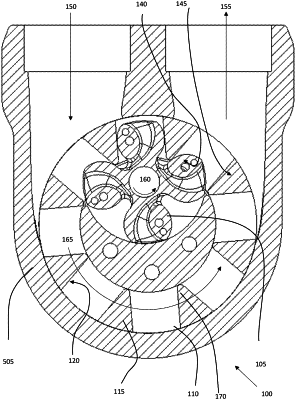| CPC F04C 2/084 (2013.01) [F04C 2/101 (2013.01); F04C 2/102 (2013.01); F04C 2240/30 (2013.01)] | 23 Claims |

|
1. A positive displacement fluid transfer device comprising:
a housing defining an inlet flow channel and an outlet flow channel;
a first rotor mounted for rotation within the housing about a first rotor axis and having first rotor teeth, and defining at least in part first rotor chambers between the first rotor teeth, each of the first rotor chambers being defined at least in part by first rotor non-axial bearing surfaces of two first rotor teeth of the first rotor teeth;
a second rotor mounted for rotation within the housing about a second rotor axis parallel to the first rotor axis and having second rotor teeth, and defining at least in part second rotor chambers between the second rotor teeth, each of the second rotor chambers being defined at least in part by second rotor non-axial bearing surfaces of two second teeth of the second rotor teeth;
the first rotor teeth and the second rotor teeth being configured to mesh together at a meshing portion of the fluid transfer device, the first rotor non-axial bearing surfaces contacting the second rotor non-axial bearing surfaces as the first rotor teeth mesh with the second rotor teeth;
the first rotor teeth and the second rotor teeth entering into the meshing at an outlet portion of the device, the meshing of the first rotor teeth and the second rotor teeth reducing the collective volume of the first rotor chambers and the second rotor chambers in the outlet portion of the device, at least the first rotor chambers being open to the outlet flow channel in the outlet portion of the device;
the first rotor teeth and the second rotor teeth unmeshing at an inlet portion of the device, the unmeshing of the first rotor teeth and the second rotor teeth increasing the collective volume of the first rotor chambers and the second rotor chambers in the inlet portion of the device, at least the first rotor chambers or at least the second rotor chambers being open to the inlet flow channel in the inlet portion of the device,
at least one of the first rotor and the second rotor defining flow channels, the flow channels being internal to the first rotor relative to the first rotor non-axial bearing surfaces or internal to the second rotor relative to the second rotor non-axial bearing surfaces, and the flow channels being arranged to connect the first rotor chambers with the second rotor chambers at least in part of the inlet portion, the meshing portion or the outlet portion of the device.
|